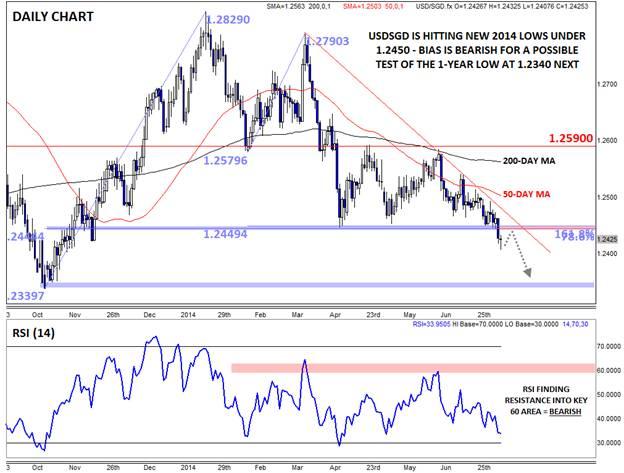![]()
Few traders realize it, but the Singapore dollar (SGD) is one of the world’s top 15 most-traded currencies, with nearly as much volume as the widely-followed New Zealand dollar and Swedish krona. The USDSGD pair has generally stayed off traders’ radar screens this year due to its lack of volatility, but with rates breaking the tight 1.2450 – 1.2590 consolidation zone, that may be about to change.
Compared to most developed nations, Singapore’s economy is a panacea. The country sports an absurdly low unemployment rate of just 2%, while simultaneously experiencing inflation of just 2.7% YoY. While there are some concerning microeconomic factors, including negative Retail Sales YoY and mediocre Manufacturing PMI of just 50.5 last month, most developed nations would gladly swap places with Singapore in terms of broad economic performance.
Unlike many other countries though, the Monetary Authority of Singapore does not use interest rates to guide monetary policy; instead the central bank manages the SGD’s exchange rate against a trade-weighted basket of major trading partners. This means that monetary authorities have sanctioned, if not directly caused, the recent move in the Singapore dollar after months of contemplation while the pair bounced around in its recent range. Therefore, this move may be more likely to extend in the days and weeks to come.
Technical View: USDSGD
While the efficacy of technical analysis is somewhat limited on currencies that are under a managed float regime, we can still draw some conclusions about the USDSGD moving forward. The recent drop to a new YTD low is very significant, and the previous support level at 1.2450 may now provide resistance on any short-term bounces moving forward. The pair may also be capped by the bearish trend line off the March high around 1.2470 as the RSI indicator continues to find resistance in the 60 area, indicative of an overall downtrend.
To the downside, the next technical level to watch will be 1.2340, which represents the 1-year low in the pair and a key area of support from late last year. If rates manage to break through that floor, a sustained period of Singapore dollar strength may be in store. Meanwhile, if the pair climbs back above the 50-day MA at 1.2500, the outlook would shift back to neutral in the short term.
This research is for informational purposes and should not be construed as personal advice. Trading any financial market involves risk. Trading on leverage involves risk of losses greater than deposits.
Recommended Content
Editors’ Picks
EUR/USD regains traction, recovers above 1.0700

EUR/USD regained its traction and turned positive on the day above 1.0700 in the American session. The US Dollar struggles to preserve its strength after the data from the US showed that the economy grew at a softer pace than expected in Q1.
GBP/USD returns to 1.2500 area in volatile session

GBP/USD reversed its direction and recovered to 1.2500 after falling to the 1.2450 area earlier in the day. Although markets remain risk-averse, the US Dollar struggles to find demand following the disappointing GDP data.
Gold climbs above $2,340 following earlier drop

Gold fell below $2,320 in the early American session as US yields shot higher after the data showed a significant increase in the US GDP price deflator in Q1. With safe-haven flows dominating the markets, however, XAU/USD reversed its direction and rose above $2,340.
XRP extends its decline, crypto experts comment on Ripple stablecoin and benefits for XRP Ledger

Ripple extends decline to $0.52 on Thursday, wipes out weekly gains. Crypto expert asks Ripple CTO how the stablecoin will benefit the XRP Ledger and native token XRP.
After the US close, it’s the Tokyo CPI

After the US close, it’s the Tokyo CPI, a reliable indicator of the national number and then the BoJ policy announcement. Tokyo CPI ex food and energy in Japan was a rise to 2.90% in March from 2.50%.
